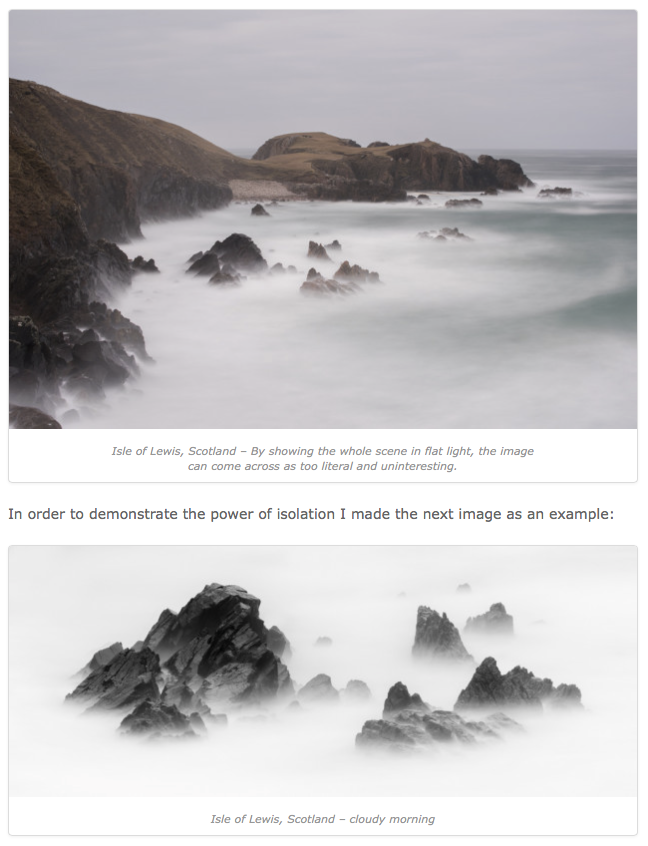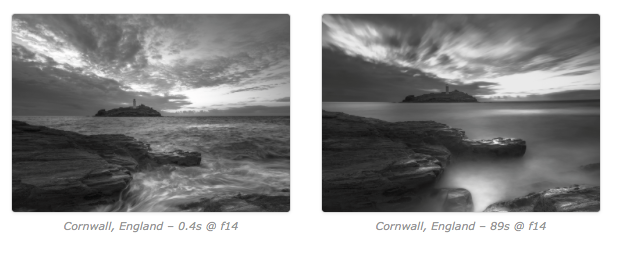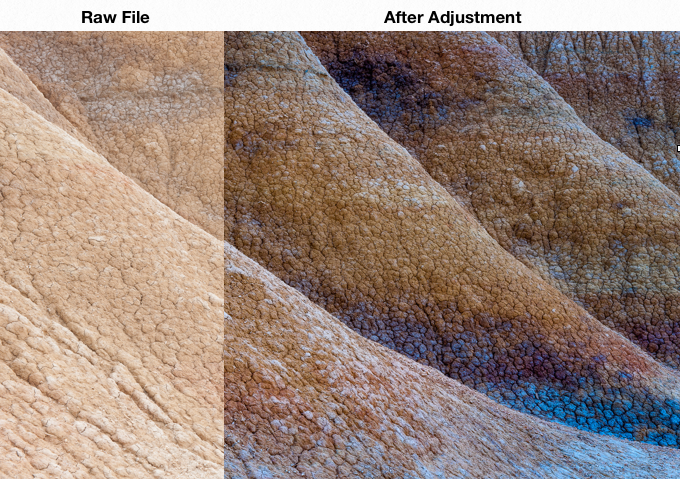Ticking away the moments that make up a dull day…
The opening line of “Time” from Pink Floyd’s Dark Side of the Moon album; 10 words I repeat often when the world seems to conspire against my creative will. If I had a buck for every time a photographer at an iconic location said to me “Shame there aren’t any clouds” – well, I’d have about $70, but you get the point!
Time is precious, moments in the wilderness or in nature are priceless and people work hard to enjoy some solitude and tranquility. If you choose to spend some of this time outside making photographs, the weather and shooting conditions are important and it is very easy to measure your enjoyment of your free time by the quality of the images you make.
In this article I aim to demonstrate that even on days when there are no clouds or spectacular colour, with harsh light, mist, fog or even rain, that our lives can be filled with creativity and beauty.
1: Contrast & Impact
One measure of photographs is their impact – essentially how they make you feel. There are numerous tools to elicit reactions from viewers, but at their core is contrast – both global and local.
If we take the image above as an example – overall this shot has high contrast, a full range of tones between pure black and pure white. If this image had a voice (it has, you just need to listen) it would be a loud “HEY, YOU – CHECK ME OUT!”
The image below however, is generally lower contrast with a majority of bright mid tones and only a few darker shadows (local contrast.)
This images voice is quieter and more delicate – more of a “I know I look like I’m drowning, but I’m actually ok!
The impact of both of these photographs is quite different and works on a very subconscious level, but note neither of them rely on golden hour light to make their statements. It is all too easy to let great light do the talking and I know from my own experience that I can become lazy in my compositions – the image is defined by the light rather than any deeper design.
Introduction
I’m sure many of us have been there; the early alarm, the drive in the dark filled with anticipation for the sunrise at our favourite spot? “Oh no, no clouds,” and the sun comes over the horizon like a giant ball of burning gas! We take one shot because we’re there and we head home under our own little personal rain cloud!
For a good few years I measured the success of my time out shooting by the images I produced, not the experiences I had. If the conditions failed to comply I would be down, if they were great (in line with my expectation), then I was happy and felt the warm glow of success. Thankfully, this is no longer the case, and I make images of what I want, when I want. If the light is great, of course I will use that to make dramatic images where light is key to the image, however, the whole spectrum of other shooting conditions is also perfect for me to make different images in different styles and with different messages and intentions.
What is a Photograph?
If you were to stand in the landscape with a piece of paper and a pen, you would have no problem filling that side of paper with words that described not just what you saw and the conditions, but how you felt about it. No more than one side of paper though – you still need to be concise. Now replace that side of paper covered with words to one covered in ink of varying colour and tone – this is your photograph and it needs to be just as concise and articulate. Our images should say what we want to say about the world around us.


2: Isolation
Back in March I was running a private workshop for 18 days with a couple from Australia. We traveled over most of the west coast of Scotland and finished on the Isle of Harris. As with any workshop, the vagaries of weather very much set the itinerary for each day and as can be seen from the first image below, when we got to this section of coast at around 10am the sky flat and I took this image of what we “saw.”
By isolating the main interest out of the landscape and removing distractions that diminish our messages we can make more powerful and interesting images. This is the classic less is more and again it does not rely on great light, instead letting its own structure and three dimensionality retain the interest. The long exposure (120 seconds) was used to remove any trace of texture from the water surface to isolate the rocks further from any other element.

3: ND Filters
When people ask “what is the correct exposure for this shot?” I usually say “That depends on what you want to say.” The reason for this is that I work with a method called Creative Exposure. In an article a couple of years ago for Topaz I wrote a simple, yet profound line:
Aperture = Depth / Shutter Speed = Mood
I still adhere to that and rarely use technical language, preferring to use emotional or “artistic” words. If we look specifically at Mood – we can see from the two images below taken a few minutes apart that the mood and impact of them is different. One is more energetic while the other is calmer and less cluttered. The only difference is Shutter Speed.
One Rule of Thumb – Don’t use Rules of Thumb!
It is not possible to make a general statement of fact and say a certain shutter speed is “perfect” for certain things. “0.6s is ideal for shooting waterfalls… etc” Movement/flow is determined by how fast something is moving and how far it moves relative to you in a given time. Try different speeds and with experience you’ll discover which looks best to you.
ND filters are simply used to slow down shutter speeds, especially during the day. If you put a 10 stop ND on a camera in low light when you already have a one second shutter speed, the duration of the resultant exposure would be over half an hour!
If nothing in the frame is moving you don’t need to use ND filters!
4: Use Transitions
We have already discussed the ideas of Global vs Local Contrast and seen some examples of High and Low Contrast images. Where great light is not necessarily the main interest in an image, these contrasts are vital to hold a viewers interest. I believe interesting photographs contain transitions between different areas of contrast.
Overall Contrast determines the initial impact of the image – High Contrast tend to be a bit more WOW, whereas low contrast, more ethereal images tend to elicit a contemplative calming response.
Local Contrast tends to be more effective at isolating areas of note within a frame and can include shaping subjects with three dimensionality of enhancing the textural attributes of the surface.
The image below can demonstrate both Global and Local Contrasts and the Transitions between them.
The pool of water is luminous against a textured sand surface helping to isolate it and making the shape very well defined. The enhanced sand textures coming in from the bottom right help to further determine that transition between sand and water. The background has a pleasing pointy shape and enhances the source of light, but I’ve been careful to make it less contrasty than the foreground, which helps to preserve natural depth in the frame.
Transitions can be almost anything, between round shapes and smooth surfaces, light to dark, smooth to rough, pointy to rounded etc. In colour we also have the transitions between warm and cool as well. Start to look at images to determine if good use of transitions is evident and if so what the transitions are.

5: The importance of Foreground Interest
On days with gloomy overcast cloudy skies, effective use of foregrounds can liven up images immensely. If it’s moody and overcast I make moody and mysterious images of interesting things. I use what’s there to make something expressive of the experience. Rarely will I go out and fail to find something that I find stimulating.
In the image below from the Fairy Pools on the Isle of Skye I used the luminous clarity of the blue water and red granite boulders to add colour to a scene without a colourful sky.
6: Find the Star and let it shine
If you look at various forms of Photography: Birds, Wildlife, Portraits, Fashion, Weddings etc, each shot tends to have a very clear subject (person or animal) against a complimentary background. The more stars you try to put in one image, or the more complex the background, the more complicated it gets to rationalize and simplify images.
Landscape photography for me has become about the isolation of interest – what is it in the landscape that I find most stimulating? Often by photographing that element and composing the rest of the distracting stuff out of it I can get to the core of the landscape in the most simple, stripped down manner.
What is the star in the image above? For me it is the luminous sand-filled rock pool and the interesting supporting cast of rock textures and incongruous sea colour. The heavy overcast sky adds mood and drama to an already dark and mysterious image – it is indicative of the place and the nature of the environment, while removing any distracting high contrast light or annoying reflections.
7: Shoot more Black and White
Moody subdued light can work well in colour as they can be quite pastel and delicate. In brighter midday light however most images will have a strong blue colour cast and look quite washed out. A good composition will work in black and white and strips the image from its attachment to reality. Using some or all of the devices, we can make interesting images in any light. Transitions, foreground interest, moody skies, long exposures – they all work in BW.
8: Shooting Possibilities
This is not meant as a definitive list and you should explore your own local areas to find suitable places to work you magic. All of these images were taken locally to me as I tend to shoot what I see all the time.
- Flowing Water (Oceans, rivers etc)
- Forests (Ideal in overcast and rain)
- Lakes (Reflections or long exposures)
- Fog (Forests, Mountains, cityscapes!)
- Dead Trees (In water or against moody sky)
Essentially, this has been an article about composition, which I hope has demonstrated that great light is not a pre-requisite for an interesting, expressive, creative photograph. Sure, if the light is there, use it! But, don’t let the absence of great light turn down your enthusiasm for discovery. Landscape Photographers are an inquisitive bunch and we’ll seek out interesting things on any walk, anywhere.

Summary Checklist
- If you’re going to include an overcast sky, fill the foreground with interest.
- Consider the Global Contrast – High or Low – this determines the initial impact.
- Look for transitions to add interest – study the work of photographers you admire to look for this.
- Forests and Waterfalls work really great in flat light, especially after rain.
- Gloomy skies make for super moody images.
- Create more Black and White images where colour is by nature absent.
- Use ND filters to create long exposures to reduce surface clutter on bodies of water.
- Isolate the areas of interest from the general landscape – reduce clutter at every opportunity.
- In fog or mist, head for the woods or a lake.
Have fun out there….




